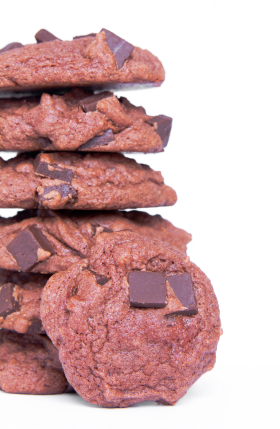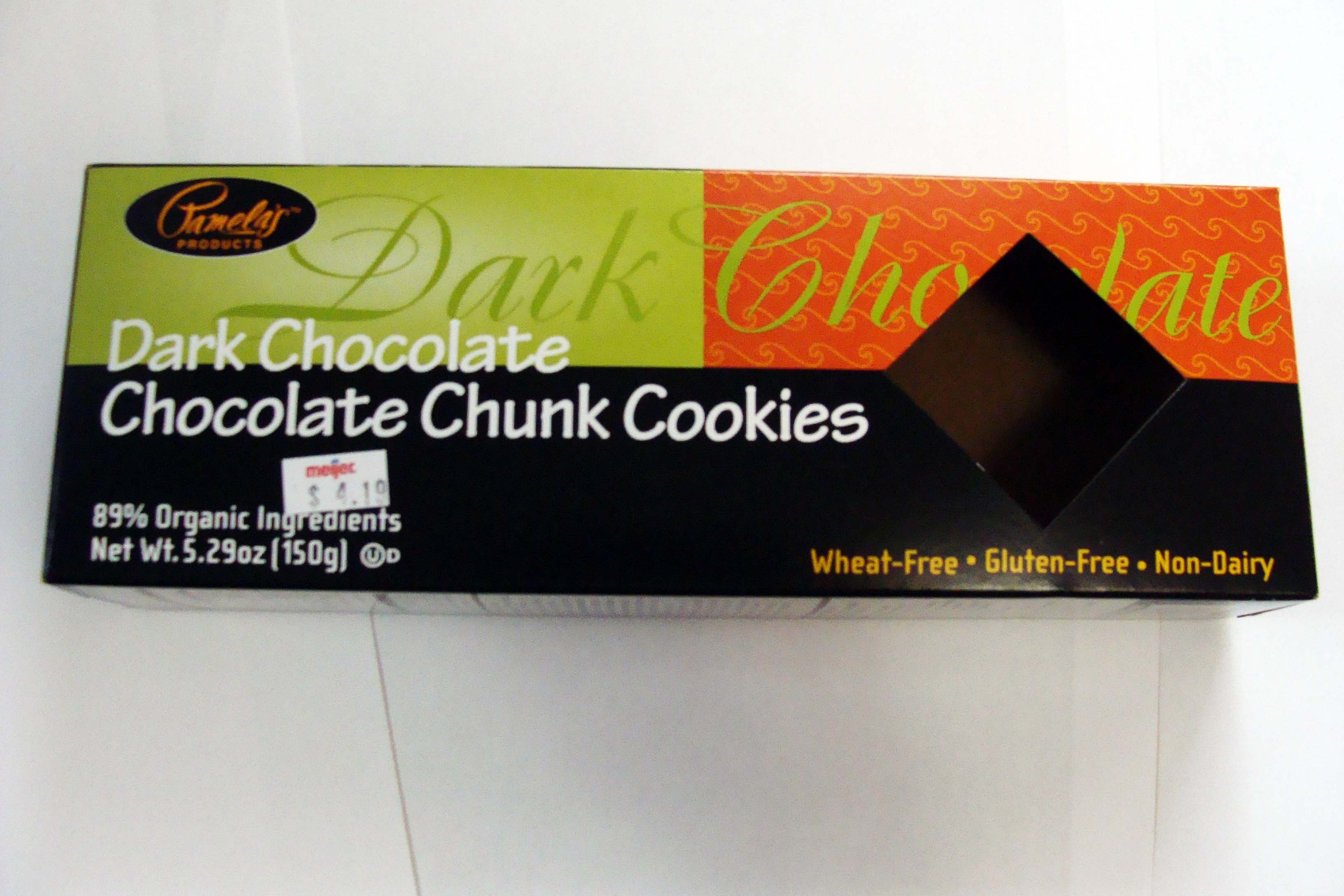On Cookies, Cravings & Mis(taken) Labelings.
 Tuesday, May 3, 2011 at 2:32PM
Tuesday, May 3, 2011 at 2:32PM  Elisabeth Veltman, The Tender Foodie tagged
Elisabeth Veltman, The Tender Foodie tagged  FDA,
FDA,  chocolate,
chocolate,  cookies,
cookies,  cravings,
cravings,  dairy-free,
dairy-free,  food allergies,
food allergies,  gluten-free,
gluten-free,  labeling laws,
labeling laws,  non-dairy,
non-dairy,  nut-free
nut-free  Email Article
Email Article  Print Article in
Print Article in  Food Allergy Facts,
Food Allergy Facts,  Labeling,
Labeling,  Product Review
Product Review The Cravings Made Me Do It

When I started this post, I was about to extol the taste and virtues of these Dark Chocolate, Chocolate Chunk Cookies. I was about to say how delicious and satisfying they are (and they are); and how much I admire the company who made them for going the extra mile to include multiple allergies. But when I double-checked the ingredients to be sure I was writing about them accurately, I realized why I had such a rough couple of nights after eating them. Until then, I simply could not pinpoint the reason for my body's allergic reaction.
Before I go on, let me add that If gluten is your only allergy and you love chocolate, these cookies from Pamela's Products are some of the yummier G-free cookies out there. Go get 'em.
But they are not yet "dairy-free", even though the label says, "Non-Dairy". Since I have an allergy to all dairy products, even traces of dairy can cause a reaction. I'm embarrassed to say that my craving for chocolate coupled with the sound of the word "cookie" just drove me to the shelf without doing my usual ingredient-reading homework. This mistake plus an FDA approved, but outdated labeling technique, led me down a path that was painful, but interesting. So, I'm going to use this experience to discuss a few very important things:
- Non-Dairy & Vegan vs. Dairy-free labeling
- Why it is important to call the manufacturer if you have a clear allergic reaction to their product
- How a responsible company/manufacturer should and did respond
- The possibility for allergen-free product companies and factories to expand their mutual markets if they cooperate on a larger scale.
My Conversation with Pamela's Products
Usually, I am a fastidious ingredient checker -- even if I've used a particular product before. You never know when the manufacturer of a product might change their recipe. Sometimes, one producer of just one ingredient could add nuts, dairy or some other allergen to their facility. But when I picked up this box, I let the little snack devil in my head make my decisions for me because of this label:
"Wheat-free*Gluten-free*Non-Dairy".

I was sure it wasn't the cookies that made me miserable. But an empty box (it had been a long time since I ate a cookie) and a couple of long days later, I turned said box over just to be sure.
On the back of the box it states in smaller letters: "ALLERGEN INFORMATION: CONTAINS EGGS, SOY, AND MAY CONTAIN TRACES OF MILK."
I picked up the phone immediately and called Pamela's customer service department. I was upset. The customer service rep had their marketing director, Stephanie call me back within minutes. We had an intelligent discussion about several things.
The Real Meaning of "Non-Dairy" & "Vegan"
"Non-dairy" means that there are no dairy ingredients listed in the product. But the FDA does not define the term "non-dairy", each state does. This adds complicaton for the consumer. Also, "Non-Dairy" doesn't take into account that the product, or any ingredient in the product, could be manufactured on the same equipment that also handles an allergen like dairy. Incidentally, neither does the label, "Vegan". Traces of milk or any of its derivatives (casein, whey or lactose) left on equipment from another product can be quite significant. Significant enough to cause a serious reaction.
In researching this article, I found that I am not alone in my mis-interpretation of "non-dairy". I am allergic to gluten and all forms of dairy - with a slow onset, or IgG reaction (i.e. not an IgE or anaphylaxis) that causes one or more of the following (for me): dull to sharp stabbing pain in my head, dizziness, stuffed nose, swelling (that's attractive), abdominal pain, a digestive standstill, flu-like symptoms, anxiety, numbness and sometimes a racing heart. These symptoms take several days or more to clear. I probably won't end up in the hospital because of a mistake, but some people will.
In a open letter to the FDA encouraging them to change this labeling tactic, The Food Allergy & Anaphylaxis Network (FAAN) describes another twist to the non-dairy labeling:
Many of our members have told us they have purchased “non-dairy” products for their milk-allergic children because they believed these items to be safe. Individuals often interpret “non-dairy” to mean “no dairy” and therefore do not feel it necessary to read the ingredient statement on the back of the package. In fact, doctors often advise parents of milk-allergic children to avoid “milk”, without informing the patient/parent of technical ingredient names such as casein. However, FAAN has learned of situations in which “non-dairy” items (such as whipped toppings, imitation cheeses, and soft-serve frozen desserts) have caused milk-allergic reactions in children because it was later discovered that the item contained a milk-derived protein.
Pamela's Products Takes Quick Action
In short, according to labeling laws, Pamela's Products was not wrong for labeling this product, "Non-Dairy". Plus, they specialize in gluten-free products, not products for multiple allergens. My phone call was apparently a first for Pamela's, which surprised me and yet didn't surprise me. I've learned that people are embarrassed. They are used to just sucking it up and moving on because they feel they "have no choice". Or perhaps others were just smarter than I was.
However, Pamela's recognizes that with the increase in the numbers of people with food allergies, as well as the increase in people with multple allergies - they need to evolve more ahead of their customer base. So they immediately went to work. Stephanie asked for my email address so she could keep me apprised of her conversations with Pamela herself and their managment team.
Here is what they have done so far:
- They Stopped the Presses on cookie boxes for their new "Wherever Bars" as they were being printed. This was at no small expense. When you see this new product (launched this spring) in stores, you will notice an asterisk (*) next to "Non-Dairy". This is a temporary change while they consider making more changes to the box design to accommodate better labeling. Rest assured, I'll be looking to see how the change turned out.
- They are Considering Changing Chocolate Factories. I put them in touch with Barry-Callebaut Chocolate, a fair trade, high quality company and the only dairy-free bittersweet chocolate factory line in North America. Callebaut also does not produce nuts or gluten products in their factory, but right now, they only test for dairy.
I appreciate the concern and action from Pamela's Products and have great respect for their immediate response. In fact, I called them on April 8, 2011 and received these results on April 12, 2011. They very kindly made it clear that they want to hear from their customers (so give them feedback!), so they can "strive to be the best".
An Expanding Food Allergy Market
Perhaps it is the marketer in me, but I see a huge mult-beneficial opportunity here. If Callebaut agrees to test also for gluten and nuts, both Pamela's and Callebaut could theoretically expand their markets - possibly significantly.
Here's some quick data for the United States alone:
- Over 12 million Americans have some kind of diagnosed food allergy - that's 1 in 25 people (FAAN)
- Over 3 million (1 in 133) have celiac disease (celiac.org)
- Millions more have diseases that require a restricted diet (some resources say 3 million, others closer to 11 million)
- Peanut allergies have tripled from 1997-2008 (FAAN)
- There are 4 times more people with celiac than there were 50 years ago (March 2011, University of Maryland study)
- 18 million people suffer from gluten-sensitivity (March 2011, University of Maryland study)
- Many people are developing multiple allergies (data not conclusive)
More data on this expanding market is coming out every day. My hope is that more Tender Foodies with nut, dairy and gluten allergies (and more?) can experience the products of great companies like Pamela's and Barry-Callebaut. If my greatest wish could become true, all ingredients would be organic and non-GMO. Eutopia would be if we could find the cause of food allergies and make them disappear.
While there are some real limiations that need to be acknowledged, something close to Eutopia could be only a few decisions away.
Enough of us just have to ask for it. Tell me what you think.
----------------------------------------------------------------------------------------------------------------------------------------------------------------------
Recommended Reading: The Wall Street Journal Article on the Gluten Study
How do I get tested for Celiac?

